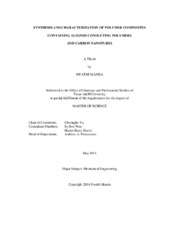| dc.description.abstract | Miniaturization of electronics and impending demand for bendable electronic gadgets creates a dire need for a thin and flexible film technology that would not only provide spot cooling for the crammed transistors, but also tap into the waste heat generated to produce a portable power source. Thin film thermoelectrics offer a viable solution and have several structural, chemical and economical advantages over inorganic thermoelectric materials. However, their low power factor compared to that of inorganic materials prevents them from being used for practical applications. The tradeoff between Seebeck coefficient and electrical conductivity restricts the improvement of power factor through increase in number of charge carriers. However, controlled modulation of the mobility of charge carriers has a potential to increase the electrical conductivity without adversely affecting the Seebeck coefficient. This research involves investigating a novel way to fabricate organic thermoelectric thin films with high power factor by modulating the morphology of the conducting polymer poly-(3,4-ethylenedioxythiophene) (PEDOT) and creating a composite with carbon nanotubes to control the mobility and hence the electrical conductivity of the thin films. Aligned PEDOT-carbon nanotube composite thin films were fabricated and characterized to study both the alignment of the polymer chains and change in their electrical conductivity.
This research utilized the bottom up self organized molecular system templates to control the nano structure and ordering of the polymer–carbon nanotube composite. Liquid crystal template was used to capture all the monomer (3,4-ethylenedioxythiophene) EDOT molecules within the cylindrical cores of hexagonal mesophase oriented in effective net direction within domains, and the monomers were electro-polymerized to obtain aligned polymer chains. This aligned structure renders better anisotropic electrical conductivity along the polymer chain direction. A non percolated dispersion of carbon nanotubes and dopants was incorporated into the aligned PEDOT thin film by spraying as well as internally dispersing within the liquid crystal network before polymerization. The carbon nanotube and dopant incorporation into the aligned PEDOT thin films increased the electrical conductivity by about two orders of magnitude. | en |


